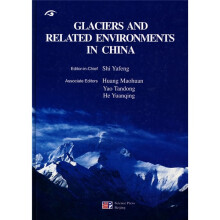FOREWORD Ⅰ
FOREWORD Ⅱ
PREFACE
CHAPTER 1 INTRODUCTION
1.1 CLACIERS, CRYOSPHERE AND GLACIOLOGY
1.2 DEVELOPMENT OF GLACIOLOGY IN CHINA
1.2.1 Preliminary Development during 1958-1977
1.2.2 Relatively Steady Development of Glaciological Research since 1978
1.3 SOCIAL SIC-NIFICANCE OF GLACIOLOGICAL RESEARCH
1.3.1 Applications to Studies of Water and Tourism Resources and Their Rational Utilization
1.3.2 Effective Mitigation of Glacier and Snow-Induced Disasters
1.3.3 Valuable Information Sources of Climate and Environment
1.3.4 Inspiring Future Generations
REFERENCES
CHAPTER 2 GLACIERS AND THEIR DISTRIBUTION IN CHINA
2.1 CONDITIONS FOR GILACIER DEVELOPMENT
2.1.1 Mountains and Glacier Development in West China
2.1.2 Climatic Conditions of Glacier Development
2.2 MAIN RESULTS OF THE GLACIER INVENTORY OF CHINA
2.2.1 The Glacier Inventory of China
2.2.2 Glacier Volume
2.2.3 Distribution of Glaciers by Province (Region)
2.2.4 Distribution of Glaciers by Mountain System
2.2.5 Distribution of Glaciers by Slope Orientation
2.2.6 Distribution of Glaciers by Water I)rainage System
2.3 GLACIER TYPES AND THEIR REGIONAL DISTRIBUTION
2.3.1 C1ass;float;on in Terms of Geophysical Properties
2.3.2 Classil.ication in Terms of Morphology and Distribution Characteristics of Morphological Types
2.3.3 Relation between Glacier Morphological Type and Glacier Size
2.4 SNOW LINE AI,TITUDE AND ITS SPATIAL DISTRIBUTION
2.4.1 Method to Determine the Snow Line Altitude
2.4.2 Spatial Distribution of the Snow Line Altitude and Its Dependent Factors
2.4.3 Accumulation Area Ratio of Glaciers and the Factors on Which It Depends
2.5 GLACIERS LOCATED IN SOME REPRESENTATIVE REGIONS AND THEIR FEATURES
2.5.1 The Altay Mountains
2.5.2 The Tianshan Mountains
2.5.3 The Qilian Mountains
2.5.4 The Pamirs
2.5.5 The Karakorum Mountains
2.5.6 The Kunlun Mountains
2.5.7 The Qangtang Plateau, Especially the Purog Kangri Ice Field
2.5.8 The East Section of the Nyainqentanglha Range
2.5.9 The Mount Gongga and Mount Yulong of the Hengduan Mountains "
2.5.10 The Middle Section of the Himalayas
REFERENCES
CHAPTER 3 PHYSICS OF GLACIERS
3.1 DISTRIBUTION OF TEMPERATURE IN GLACIERS
3.1.1 Introduction
3.1.2 Heat Transfer in the Near Surface Layer
3.1.3 Heat Conduction at the Glacier Base
3.1.4 Heat Transfer within a Glacier
3.1.5 Two-Dimensional Temperature Distribution
3.1.6 Temperate Glaciers
3.1.7 Types of Glacier Temperature Distribution
3.2 ICE FORMATION
3.2.1 The Transformation of Snow to Ice
3.2.2 Glacial Zonation
3.2.3 Glacial Zones in the Main Glacierized Areas
3.3 ICE TEXTURES
3.3. 1 The History
3.3.2 Crystal Size
3.3.3 c Axis Orientation
3.3.4 The Features of Ice Textures in China
3.4 MECHANISMS OF GLACIER MOTION
3.4.1 ABriefView
3.4.2 Deformation of Ice
3.4.3 Basal Sliding and Deformation of the Bed
3.4.4 Hydraulic Effects at the Glacier Bed
3.4.5 A Summary of Motion Mechanisms of Glaciers in China
REFERENCES
CHAPTER 4 MASS AND ENERGY BALANCE OF GLACIERS
4.1 FUNDAMENTAL CONCEPTS AND MEASUREMENT METHODS OF MASS BALANCE
4.1.1 Fundamental Concepts
4.1.2 Significance of Mass Balance Study
4.1.3 Methods of Measurement and Calculation
4.2 MASS BALANCE MEASUREMENTS IN CHINA
4.2.1 Current Situation of Mass Balance Measurements
4.2.2 The Primary Measured Results
4.3 CHARACTERISTICS OF MASS BALANCE OF GLACIERS IN CHINA
4.3.1 Temporal Processes and the Characteristics of Mass Balance
4.3.2 Relations between Mass Balance, ELA and Meteorological Variables
4.4 METHODS OF MASS BALANCE ESTIMATION
4.4.1 For A Single Glacier
4.4.2 For a Drainage Basin
4.5 CHARACTERISTICS OF ENERGY BALANCE OF GLACIERS
4.5.1 The Heat Components for Glacier Development
4.5.2 Special Climate Factors on Glaciers
4.5.3 Features of Heat Balance at a Glacier Surface
4.6 CASE STUDIES OF HEAT BALANCE
4.6.1 In the Glacier U-1
4.6.2 In the Dongkemadi Glacier
4.6.3 In the Chongce Ice Cap
4.7 STUDIES BY MODELING
4.7.1 Glacier State Model
4.7.2 Glacier Process Model
REFERENCES
CHAPTER 5 SNOW AND ICE CHEMISTRY AND ITS ENVIRONMENTAL SIGNIFICANCE
5.1 WHAT IS SNOW AND ICE CHEMISTRY?
5.1.1 The Principal Aspects of Snow and Ice Chemistry and Approaches to Research
5.1.2 An Overview of Developing Trends in the Study of Snow and Ice Chemistry
5.2 THE MAJOR ANIONS AND CATIONS IN SNOW AND ICE AND THEIR ENVIRONMENTAL SIGNIFICANCE
5.2. 1 The Significant Difference of the Atmospheric Environment in the South and North Parts of the Tibetan Plateau
5.2.2 The Environmental Significances of Various Chemical Ions
5.2.3 Comparison with Snow and Ice Chemistry in Polar Regions
5.3 THE INSOLUBLE MICROPARTICLES IN SNOW AND ICE
5.3.1 The Climatic and Environmental Significances of the Insoluble Microparticles in Ice Cores
5.3.2 The Distribution Characteristics of Insoluble Microparticles in Shallow Ice Cores on the Tibetan Plateau
5.3.3 Atmospheric Processes Influencing the Dust in Glaciers before Deposition
5.4 STABLE OXYGEN ISOTOPES IN SNOW AND ICE AND THEIR CLIMATIC SIGNIFICANCE
5.4.1 Relationship between δ18O and Temperature in Observations through the Year
5.4.2 Seasonal Variations of δ18O Values of Precipitation on the Tibetan Plateau
5.4.3 Spatial Variations of δ18O Values of Precipitation on the Tibetan Plateau
5.5 MECHANISM OF ICE CORE RECORD FORMATION
5.5. 1 Air-Snow Exchange Processes
5.5.2 The Post-Deposition Process Elution of Ions in Snow and Ice
5.6 ORGANIC MATTER AND MICROBES IN SNOW AND ICE
5.6.1 Preliminary Research on Organic Acids in Snow and Ice
5.6.2 The Micro-organisms in Snow and Ice
5.6.3 The Climatic and Environmental Implications of Organic Matter in Snow and Ice
REFERENCES
CHAPTER 6 SNOW COVER DISTRIBUTION, VARIABILITY, AND RESPONSE TO CLIMATE CHANGE IN CHINA
6.1 ENVIRONMENTAL SIGNIFICANCE AND MONITORING OF SNOW COVER
6.1.1 Snow Cover and Its Environmental Impacts
6.1.2 Snow Cover Monitoring
6.2 DISTRIBUTION OF SNOW COVER
6.2.1 Distribution of Annual Number of Snow Cover Days and Snow Cover Classes
6.2.2 Spatial Pattern of Snow Depth Distribution
6.2.3 Annual Cycle of Snow Cover
6.3 INTERANNUAL VARIABILITY OF SNOW COVER
6.3. 1 Brief Review of Current Knowledge and Gaps of Global Snow Cover Variability
CHAPTER 7 GLACLAL RUNOFF AND ITS MODELING
CHAPTER 8 SNOW AND ICE HAZARDS AND THEIR CONTROL MEASURES
CHAPTER 9 CLIMATE AND ENVIRONMENT CHANGES DERIVED FROM ICE CORE RECORDS
CHAPTER 10 QUATERNARY GLACLATIONS GLACIAL AND INTERGLACIAL CYCLES AND ENVIRONMENTAL CHANGES
CHAPTER 11 IMPACT OF GLOBAL WARMING ON GLACIERS AND RELATED WATER RESOURCES IN CHINA
INDEX
PLATES
PHOTOGRAPHS

 缺书网
缺书网 扫码进群
扫码进群





